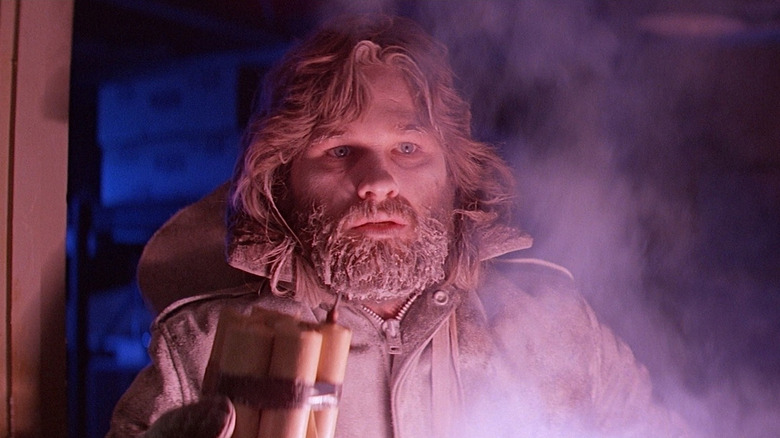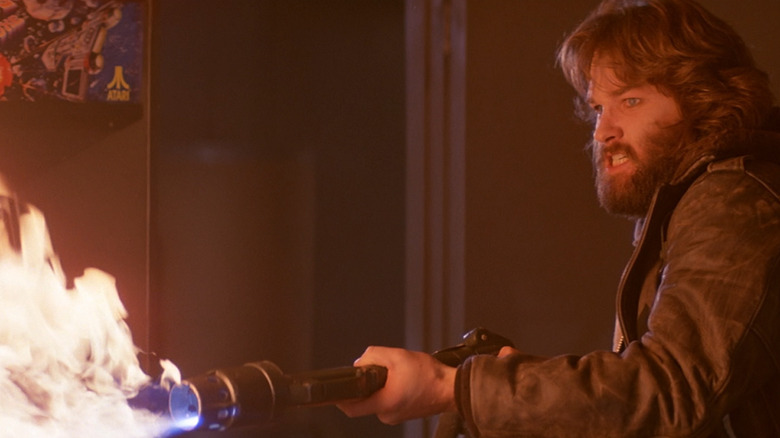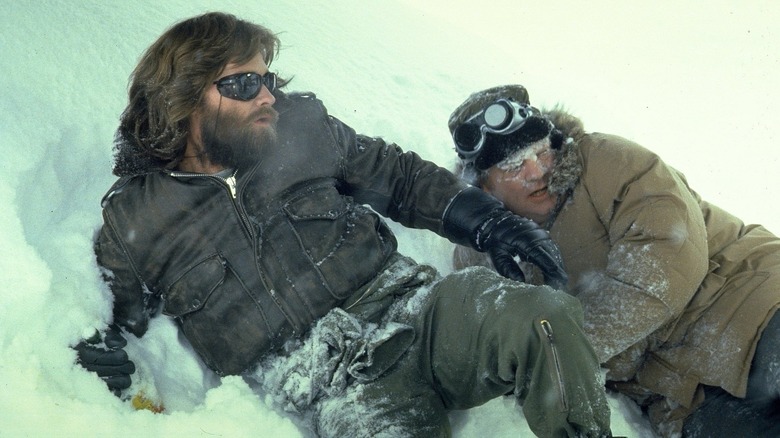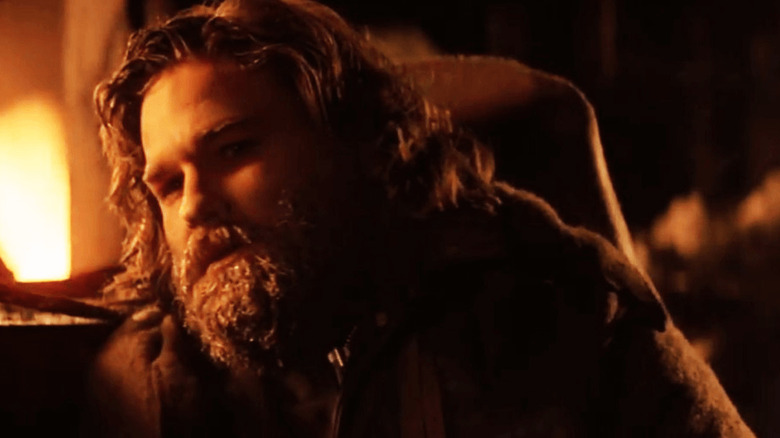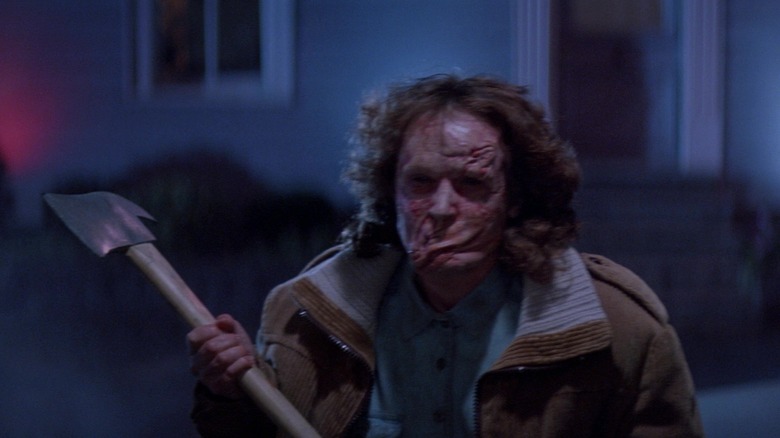The Thing Ending Explained: Wait Here A Little While And See What Happens
Based on both John W. Campbell, Jr.'s 1938 novella "Who Goes There?" and its 1951 film adaptation "The Thing from Another World," John Carpenter's 1982 film "The Thing" is often celebrated as one of the better films of its decade. "The Thing" notoriously bombed upon its initial release, a financial failure that may be attributed to the more upbeat, less nihilistic alien film "E.T. the Extra-Terrestrial" from earlier that same year. Additionally, "The Thing" is a bleak, cold, angry film, which may have been a tough sell for audiences more eager to consume larger hits like "Rocky III," "Annie," "The Best Little Whorehouse in Texas," and "Porky's."
Many pundits will be eager to point out that "The Thing" features some of the scariest and most grotesque special effects of any feature film. The titular Thing is a shapeless mass of tissue and goop that can invade the body of any living host, and replicate it exactly, even down to its brain functions and behavior. Whether or not the Thing is even conscious is a matter of debate. It could very well be an extraterrestrial parasite consuming what it needs merely in order to perpetuate itself. It may not be intelligent, driven only by vague, base biological instincts. In that regard, the Thing might be somewhat similar to the creature from Ridley Scott's 1979 film "Alien." They are both scarier as movie monsters if they are short-lived predators without sophisticated motivation.
The paranoia of men
Over the course of "The Thing," the monster invades the bodies more and more of the bearded, grizzled men working at a very, very remote Antarctic study outpost. As the team discovers what the Thing is, and how it seems to be operating, the men become increasingly paranoid. They are careful to torch the monster to death each time it appears, but it can easily spread. One member of the crew, Blair (Wilford Brimley) seems to sense that the Thing, if released into the general population, will be unstoppable. When he smashes the base's radio to protect them, he is locked in a bunker and kept there for the bulk of the film. In one tense scene, each character provides a blood sample that is subjected to a test to detect the Thing. All the while, the men all eyeball one another suspiciously. It's notable that more than one character has already been tied to a couch.
The characters from "The Thing," are all rugged. They all possess a certain machismo, and could be seen as traditional "tough guy" characters. When they're bundled up in winter coats, they even all start to look the same. Into a world of uniformity comes an Other. What that Other represents can be debated, of course. Speaking anecdotally: Some of the author's peers have said it's an invasive political ethos. Others have suggested its bigotry. It has been suggested that the Thing is fear of sexuality. Whatever the Other might be, it's something to be wary of. Something to fear and to hate.
Paranoia is key. The monster — shapeless, and able to look like anyone — appears to represent suspicion. Even if you seem to know someone, there will be suspicion of their authenticity.
The 1950s, 30 years later
That kind of paranoia was, of course, a large theme in the 1951 Howard Hawkes film that Carpenter was remaking. The infamous McCarthy Hearings wouldn't be held until 1953, but there was a very general wariness of Communism in the air. World War II had ended, and American entered an employment/housing boom that led to widespread prosperity and idealism. Cars were common. Food was plentiful. The Depression was a memory. That 1950s idealism, however, was perceived as tenuous by certain citizens. With more economic freedom came a sudden social change that old-world grumps attempted to stymie. Anything that was "different," or even suspiciously the same, was now suspect. Accusations would quickly follow. Anything different — even if one cannot see it — would have to be sought out and destroyed.
The 1980s saw a rise in conservatism in the United States. Ronald Reagan was in office, and American media began to re-introduce a lot of 1950s iconography as a way of either bolstering or tearing down post-war idealism. One might notice a lot of 1980s horror movies with greaser characters in them, or movies set in the 1950s suburbs. Carpenter's own 1983 film "Christine" is about a demonic 1958 Plymouth Fury, alive and able to rebuild itself, infecting the mind of a 1980s teen. The 1950s aren't done with us.
That's certainly true in "The Thing," a movie that is not only a remake of a 1950s film, but a perfect reflection of how 1950s paranoia was repeating itself 30 years later.
Here in 2022, when one daily receives their image of other people through their carefully constructed and curated and considered social media profiles, authenticity is once again in deeply question. "The Thing" is proving to be disappointingly timeless.
This is the end
At the end of "The Thing," only two men are left standing. MacReady and Childs (Keith David). Their base is on fire and the creature is seemingly destroyed. They are injured and tired and sitting in sub-zero temperatures. The fire is keeping them warm for now, but when it goes out, the two of them will undoubtedly freeze to death. "How will we make it?" Childs idly asks. "Maybe we shouldn't," MacReady replies. The Thing, he thinks, might still potentially be infecting one of them. But he is also resigned. "If we have any surprises for one another," he points out, "I don't think we're in any shape to do anything about it."
So what do they do? "Why don't we wait here a little while and see what happens," MacReady suggests. Ennio Morricone's score beats on the soundtrack. The monster, it seems, may be alive.
The physical monster? Perhaps. Perhaps not. I am not one to speculate as to whether or not MacReady or Childs is infected. The film intentionally leaves it ambiguous. What is known for sure is that both MacReady and Childs understand the deeper infection — that of suspicion — has definitely not been cured. The final line is not just a practical, weary way of starving the Thing out, but a fatigued, jaded acknowledgement that an evil thing within humanity makes the species not worth saving.
We can defeat paranoia, but only if we take a moment to freeze to death together. There is a definite, underlying nihilism to the end of "The Thing."
The apocalypse trilogy
Carpenter would go on to make two additional films in what would constitute an unofficial Apocalypse Trilogy.
1987's "Prince of Darkness" is about an enormous glass tube in the basement of a church that contains literal liquid evil. Scientists and priests inspect the tube, trying to understand its nature. The philosophy isn't deeply discussed, but "Prince of Darkness" takes place in a world were evil is not a way of describing actions or intentions, but a physical, outside force that can infect and eventually leak out into the world. In the near future, it will.
In 1995's "In the Mouth of Madness," one of Carpenter's best, pop literature would drive the would insane and transform humans into monsters. A Stephen King-like author has written books so powerful, they bleed into the minds of their readers. Horror, the film argues, is the one genre powerful enough to alter people's thinking. In the world of "Madness," that alteration extends to people's bodies as well, and if enough people read a book — or watch the movie adaptation — then madness will reign. The line between sane and insane, the film argues, is only a matter of perspective.
Paranoia, animosity, and pop art. The three horsemen in Carpenter's Apocalypse.
